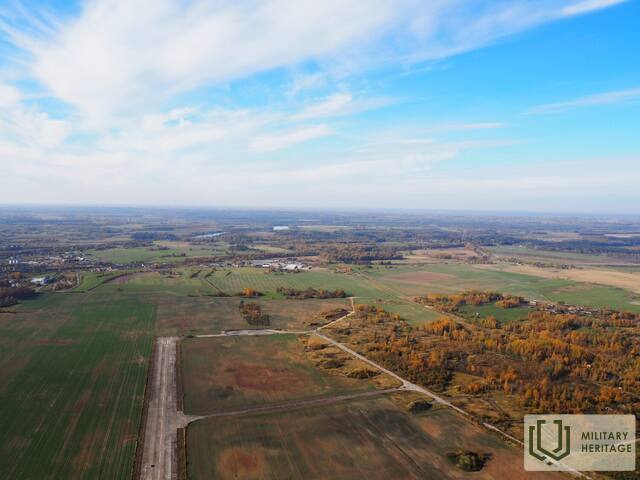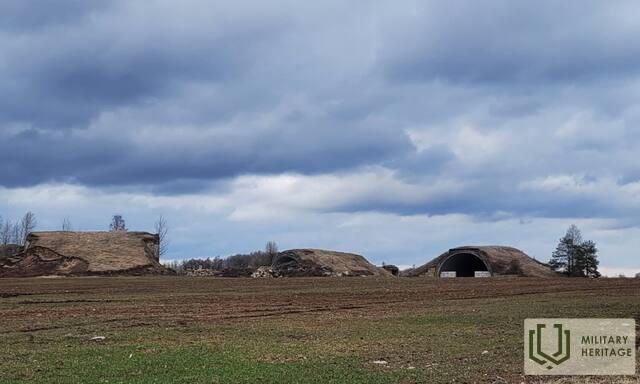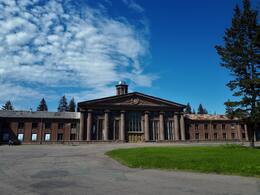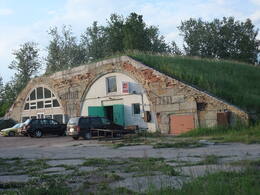Jekabpils Airport
Jēkabpils Airfield is one of the military airfields in the territory of Latvia, which was created during the period of Independent Latvia around 1935. After the second occupation of the Republic of Latvia in 1945, the airfield was adapted for the needs of the USSR Air Force.
Jēkabpils airfield is located approximately 5 km from the city of Jēkabpils, in Jēkabpils municipality, Krustpils parish. The area occupied by the airfield is 500 hectares. The length of the concrete runway was 2500 meters, of which about 2000 meters long, 40 meters wide runway have been preserved. There are more than ten small hangars in the territory, and 7 or 8 large ones, which were intended for larger aircraft. There are also 6 or 7 small bunkers - semicircular concrete hangars buried in the ground - approximately 4m in diameter. They were most likely used as communications centers, as they are located in strategically important places of the airfield. There is also one larger bunker, which was probably used as the main communications hub. The former infrastructure buildings of the airfield have been looted and destroyed. An aircraft repair hangar has survived on the airfield, an impressive structure, although it currently serves as a chip storage facility, as well as a number of other hangars. There are several horseshoe-shaped embankments on the airfield. Until the occupation of the Republic of Latvia, the airfield functioned as the Krustpils airfield of the Latvian Aviation Regiment. Around 1935, a new reinforced concrete hangar and two-story barracks were built. Before 1939, it was planned to open the Riga-Krustpils-Daugavpils State Air Line, which, however, was not implemented. After the occupation of Latvia, in 1940, the Latvian Aviation Regiment's "Gladiator" fighter planes were redeployed from the Riga Rumbula airfield to the airfield. During World War II, the Luftwaffe's 1st Fleet (Luftflotte 1) bombers were based at the Jēkabpils airfield. From 1962, Jēkabpils airfield was used as one of the military airfields on the northwestern border of the USSR during the Cold War. Until 1992, Jēkabpils airfield was home to the Soviet Air Force's 886th Special Reconnaissance Aviation Regiment (886-й Сталинградский Краснознаменный отдельный заведывательный авиационный полк, 886-й ОРАП) with two aviation squadrons, which used IL-28R (ИЛ-28Р), Yak-27R (Як 27Р), MiG-15 (МиГ-15), then Yak-28PP (Як-28ПП), and finally Su 17M4R (Су-17М4Р) and Su-24MR (Су-24МР) fighter aircraft. After the restoration of Latvia's independence and the withdrawal of the Russian army, the Jēkabpils airfield, with an area of 547.8 hectares, came under the supervision of the Ministry of Defence of the Republic of Latvia, which transferred it to the ownership of the Jēkabpils District Council without any obligations. In 1993-1999, Jēkabpils Lidosta AS operated. In 2000, the airport land was included in the state free land fund. Buildings and communications, including ammunition depots, a command post, technical and economic buildings, were privatized by SIA Reka, except for 500 runway slabs, which were distributed to district municipalities. Around 2008, an asphalt concrete factory was built on the airfield territory, and a woodworking company operates in the barracks buildings. In 2013, 7 or 8 large, demolished military aircraft hangars and more than ten smaller hangars remained.
According to MyAirfields, activists have begun renovation work on the airfield - improving the pavement at the western end, painting the navigation path, installing wind socks, etc.
• On March 27, 1986, a Su-17M4 aircraft of the 886th ORAP of the USSR Air Force approached the Jēkabpils air base. During the approach, the pilot lost spatial orientation and the aircraft crashed into the ground. The pilot was killed.
https://diggers.lv/v3/jekabpils-lidlauks/
Related timeline
Related objects
Vaiņode air base
Vaiņode airfield still has 16 Soviet-era aircraft hangars and an 1800 m section of the once 2500 m long runway. The airfield can only be visited with a previous booking. Vaiņode airfield was established during the Latvian independence as one of the cradles of Latvian aviation and was later one of the largest military airfields in the Baltic States. In 1916, two hangars for German Army airships were built. Airships were used to gather intelligence and bomb the positions of the Russian Army. Later the city of Riga bought the airship hangars and used their roof structures to build the pavilions of the Riga Central Market. In May 1940, the 31st Fast Bomber Aviation Regiment of the Red Army moved to Vaiņode, and the construction of a standardized concrete slab runway began. At the end of the summer of 1944 the partially completed airfield was used by various German aviation units, however, at the end of World War II, the same airfield was used by the Red Army aviation units fighting the German Army group called ‘Kurzeme’. After World War II the Soviet Air Forces were stationed in Vaiņode until 1992.
Spilve airport
Located in Riga, Pārdaugava, in the Spilve meadows near Iļģuciems.
Spilve is famous in the history of military heritage for the grandiose Battle of Spilve in the 18th century and the Spilve airfield. Starting in the 20th century, it was used for testing aircraft, but during World War I it became a witness to the history of Latvian aviation.
During World War I, the Spilve meadows were used by the Russian army's air force for the purposes of fighting the German army. With the creation of Latvia, the airfield became the country's most important air force base and a training ground for pilots. The airfield's previous names were "Spilves Air Port" or "Riga Air Port", later "Riga Central Airport". It was the main airport in Latvia until the opening of the airport "Riga" in 1975.
Perhaps the Spilve airfield near Riga and the dream of reaching for the stars have contributed to the impressive achievements of many Latvian pilots. Perhaps, however, the beginning of Latvian aviation is much older and can be found in Priekule, where a Latvian blacksmith Zviedris made a flight from a church tower with a homemade device.
Today, the Spilve airfield is still in operation. You can see the airport building, built in 1954, which embodies the Soviet classicism or “Stalin Empire” style.
Sources:
Irbītis, K. Latvian aviation and its pioneers. Riga: Zinātne, 2004.
Brūvelis, E. History of Latvian Aviation: 1919-1940. Riga: Zinātne, 2003.
Official website of the state agency "Civil Aviation Agency". Available: https://www.caa.gov.lv/lv/latvijas-aviacijas-vesture-isuma [accessed 22.02.2021].
Rumbula Air Base
Located in the southeast of Riga, in Rumbula, between Maskavas Street and the Daugava River.
Rumbula was home to a Soviet Army Air Force airbase and a civilian airport alongside Riga's main airport in Spilve. Both airports existed until the opening of Riga Airport. Before World War II and the occupation of Latvia, Rumbula was home to an airfield for the Latvian Army Aviation Regiment.
After World War II, the Soviet Union began producing jet-powered aircraft, which required longer and smoother runways. Old airfields were expanded and new ones were built. The changing weather conditions in the Baltics and the short flight time of the first jet aircraft were the reason for the creation of many backup airfields. The noise of jet aircraft caused dissatisfaction among the residents of Riga, because the military airfield was located too close to residential areas and could create dangerous situations. In 1973, it was closed and the Lielvārde airfield was built in its place, to which combat aircraft were transferred. Shortly before the closure, an international scandal broke out. A US Air Force officer, who was one of the military attaches in Moscow, was beaten there. He was allegedly attacked by 14-20 airport employees who suspected that the airfield was being photographed.
Today, you can visit the abandoned airfield area.
Keruspils (Jekabpils) Airport
Krustpils airfield was located near Veselmuiža. A small airfield was already there during the First World War. Its borders were slightly expanded during the Free State of Latvia. The 7th Squadron of long-range reconnaissance was stationed here. One of the commanders was Captain Ēriks Mellups. Around 1935, a new reinforced concrete hangar and two-story barracks were built. At the beginning of the war, the airfield housed aircraft that had been moved from other places and destroyed by German aviation.
During the years of Soviet occupation, the borders of the airfield were significantly expanded. In February 1941, 282 ha of land with surrounding houses were handed over to the Red Army. In April 1941, almost 700 ha were requisitioned. In this way, 152 buildings of surrounding farms were destroyed. Residents of the surrounding parishes within a 50 km zone were involved in the construction work.
In 1974, due to the expansion of the take-off and landing strip, the airfield was expanded by another 44 ha.
Today, Jēkabpils Airfield is an abandoned military airfield, partially privatized with a partially preserved runway and buildings.












